 Darjeeling
Darjeeling reminded me of Hayao Miyazaki's
Laputa: Castle in the Sky. It is hidden within the thick cloak of fog and has an elevation of up to 8000 feet. As you approach Darjeeling from the small, but heavily populated Bagdogra aiport, the steep hills slowly reveal themselves.
 Looking down to the Junpana Tea Estate from the Goomtee Tea Estate, we are above the clouds.
Looking down to the Junpana Tea Estate from the Goomtee Tea Estate, we are above the clouds.
The roads are unpaved, extremely narrow and get a lot of traffic, prompting a near-constant parade of 4x4s honking and passing each other with just a few inches between them. It was obvious that the only people who could drive on this terrain were born and raised here, with the ability to anticipate each curve and strategically placed rock that was the "guard rail" between you and a 2000ft cliff.

Darjeeling is situated in West Bengal in the northeastern corner of India. It shares borders with Tibet, Nepal and Bhutan, therefore the two industries are border control (military) and tea. What a combo! Military facilities were especially abundant right outside the airport. Because of its proximity to China, the faces of people living there were very diverse. I felt like I fit right in with my East Asian face.
 On our way to school
On our way to school
Most of the locals speak Nepali, but it is not uncommon to hear Bengali and Hindi as well. My untrained ear was unable to differentiate between these different languages.
I was on business for this trip and had the privilege of visiting a total of five tea estates, mostly situated in the
Kurseong sub-district of Darjeeling (there are three wards in Darjeeling: Kalimpong, Kurseong and Siliguri).
I stayed in the bungalow at the
Goomtee Tea Estate for four nights.
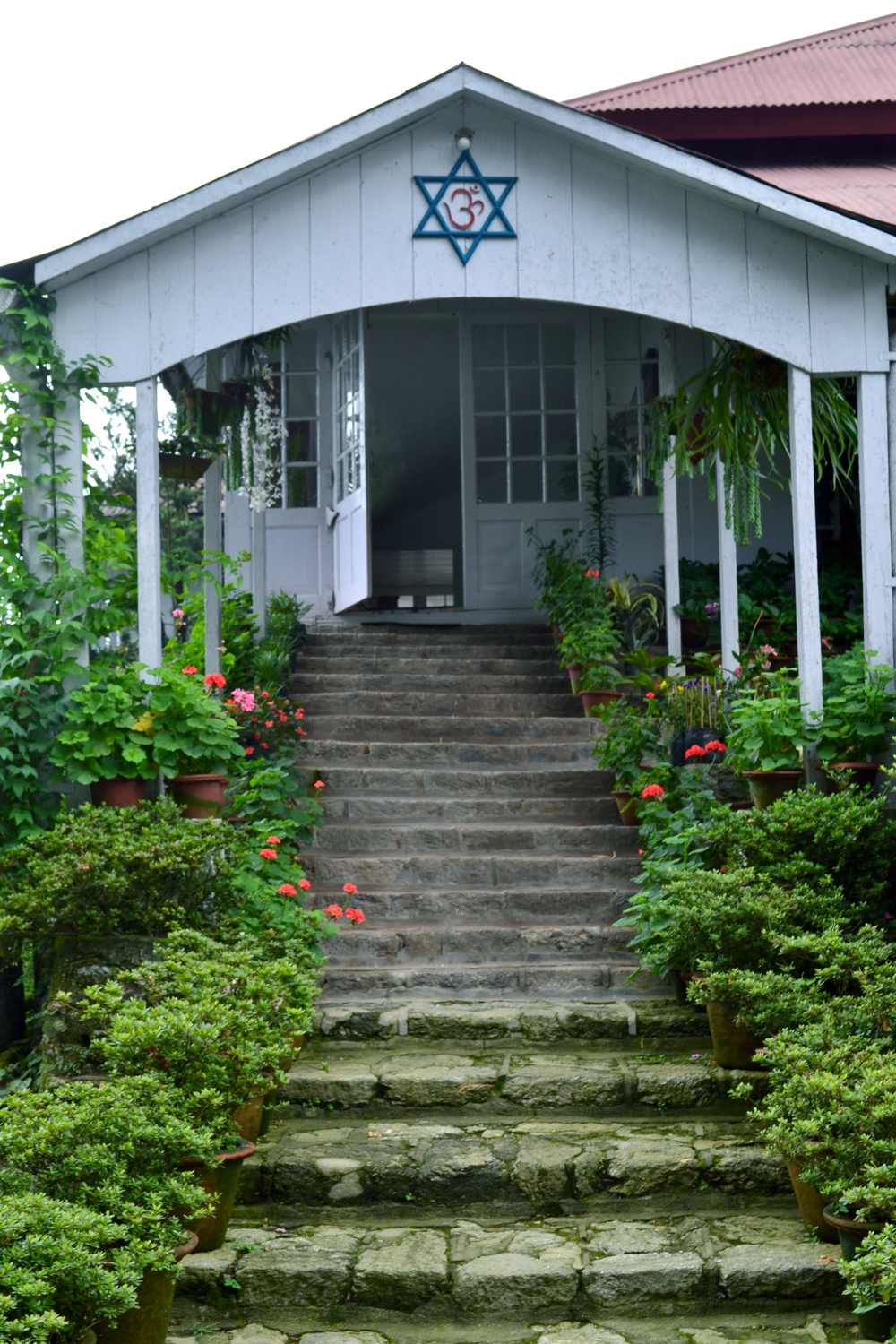
It was established by the British in 1899 so the buildings are really classic, reminding me of my Grandma's English Tudor house she used to live in.

Creaky floors, lots of spiders, but great A-frame rooftops and deep brown wood flooring worn out by over a hundred years of people walking over them. The rooms were very comfortable, but I definitely had to get used to the fact that I had to turn the water heater on at least an hour before taking a shower.

Prem was the head chef at the bungalow.

He showed me around their kitchen. There were usually a staff of three making our meals.
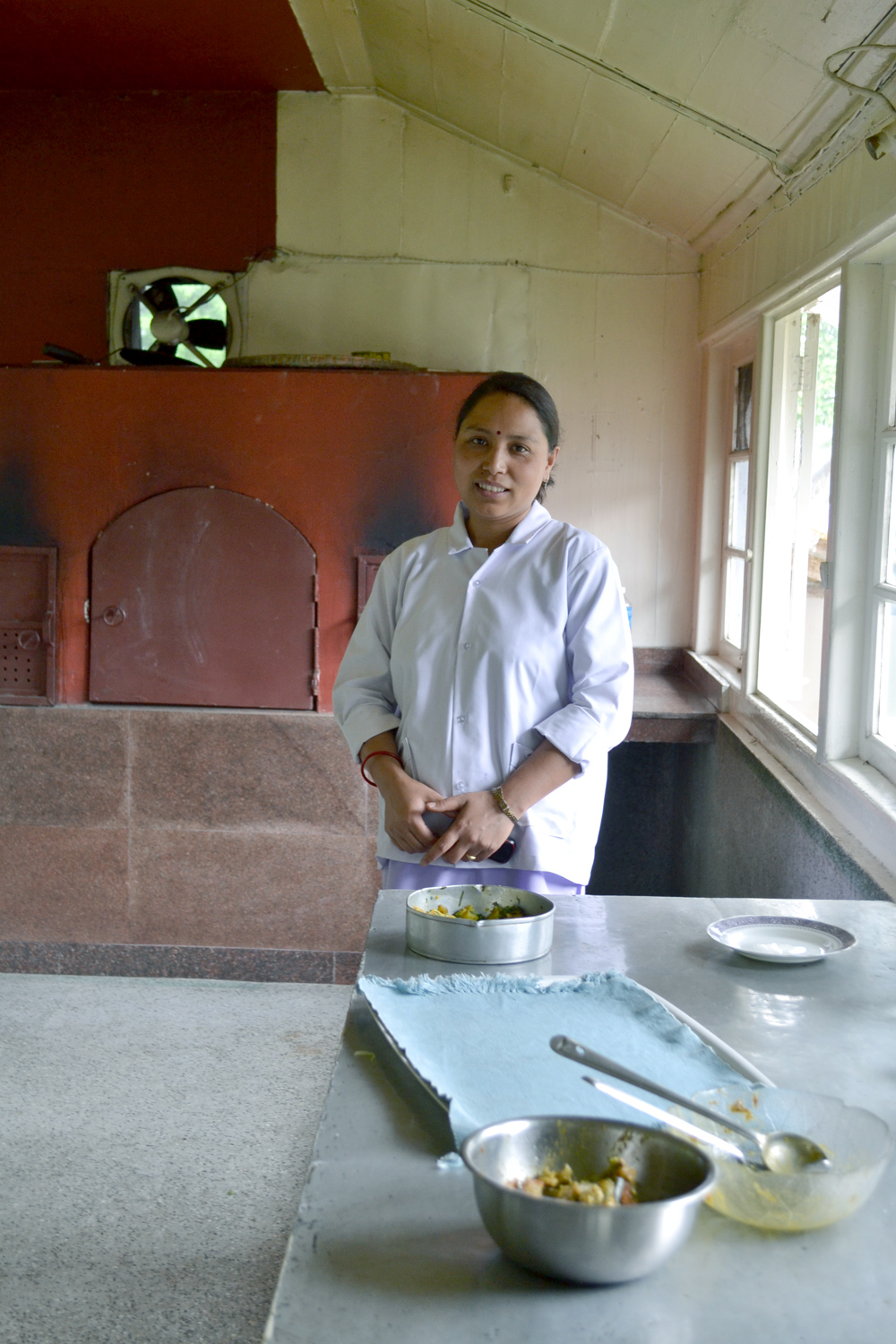
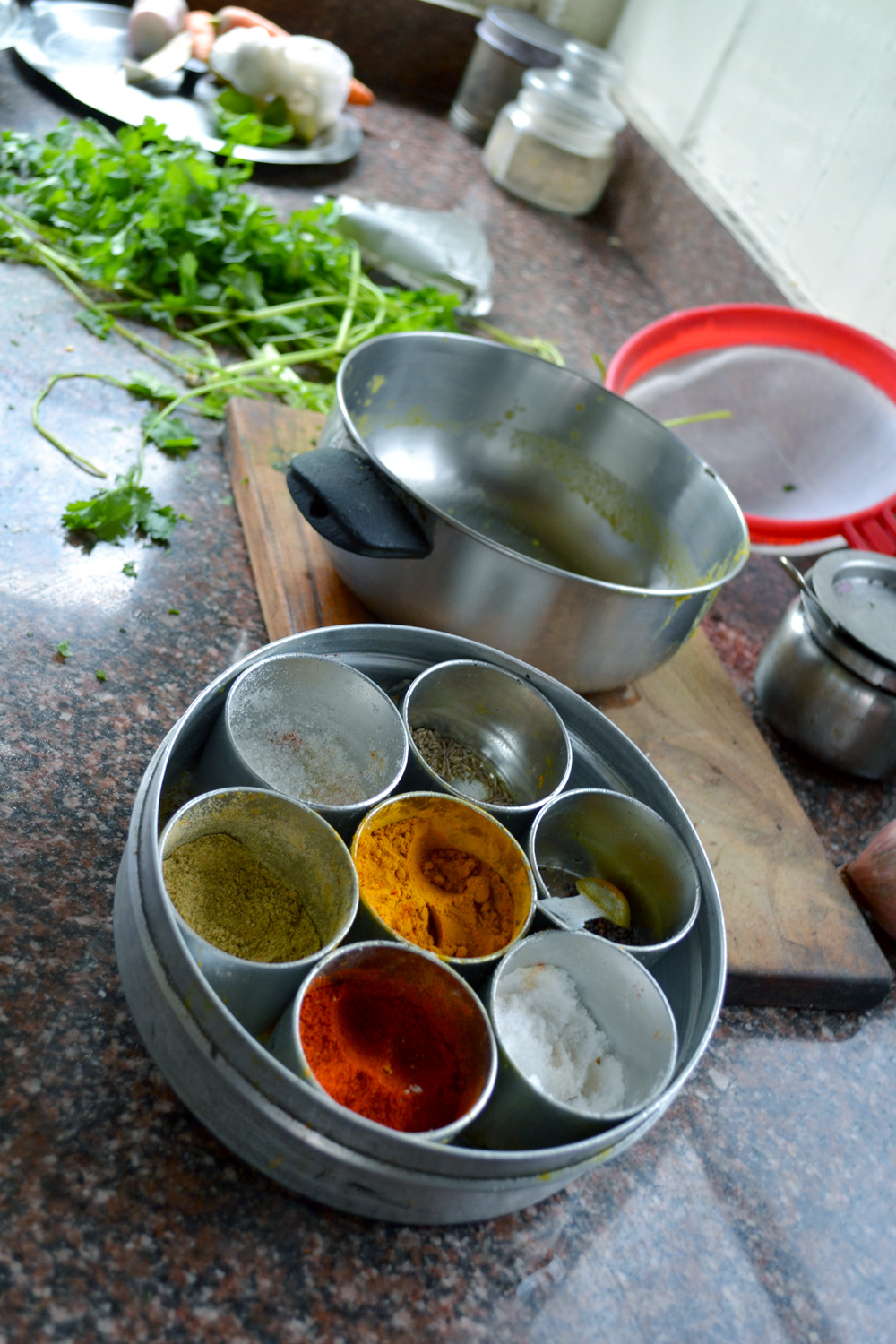

All of the food was vegetarian and they harvest all of their herbs from the garden. The vegetables were all local as well, highlighting the fertility and abundance the Darjeeling's moisture and soil.
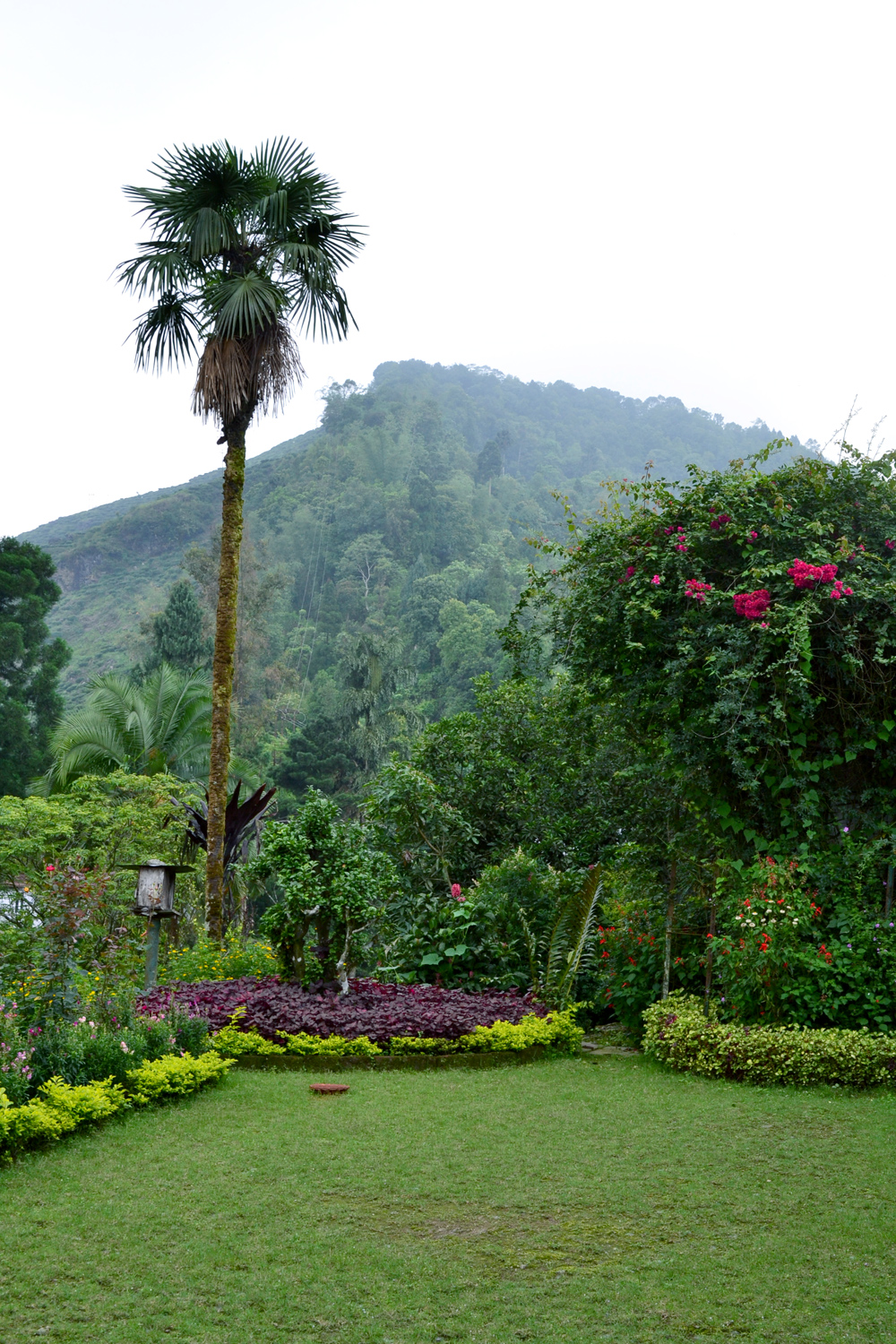 Goomtee garden, karipatta tree bottom left of the palm tree.
Goomtee garden, karipatta tree bottom left of the palm tree.
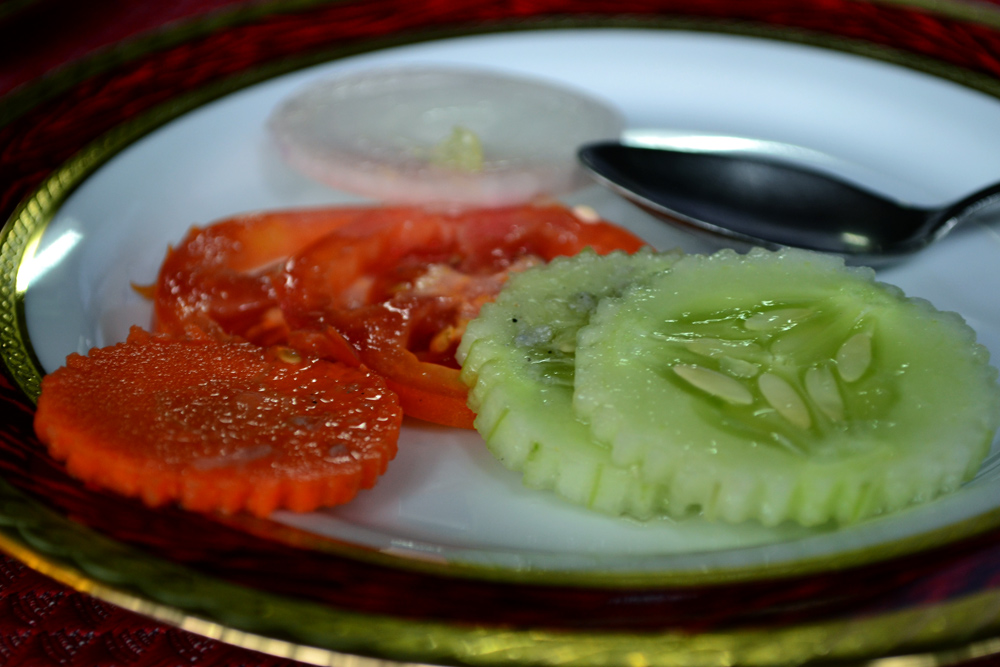 Salted vegetables
Salted vegetables
There was always a protein element, often made out of beans (pictured here in the glass bowl on the top left hand side). And yogurt was mandatory for all meals, which was served after the main spread. With this combination, I did not feel like I was "missing" meat or lacking in energy. The meals there were cleansing and bright. It was quite a contrast from the
Rogan Josh (mutton curry) I had in Delhi the day before.
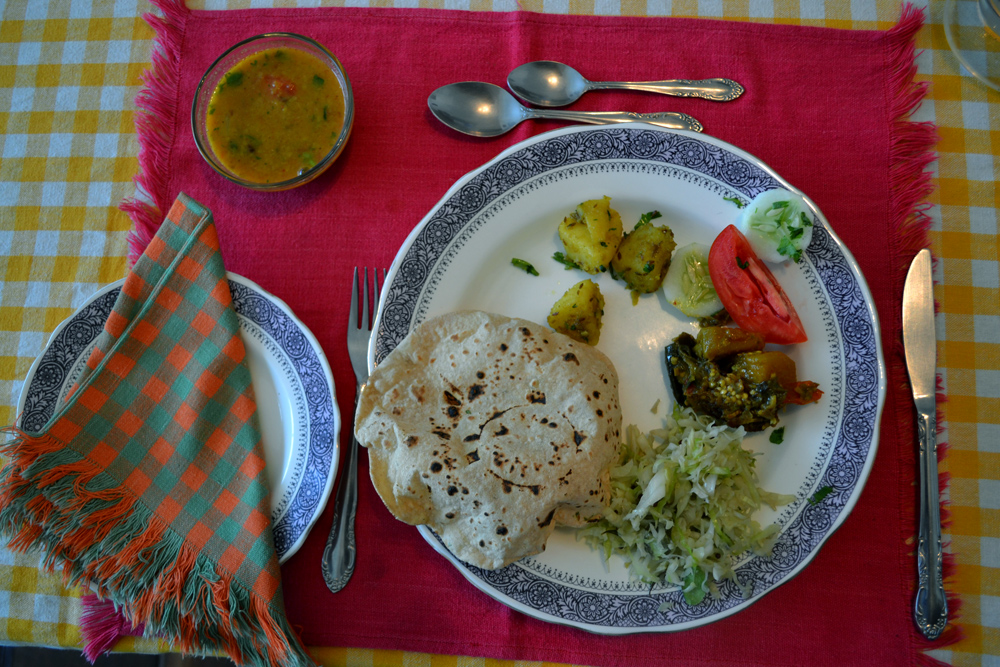
The bread was made fresh every day in their kitchen.

Using whole grains, this was a very thin type of bread that reminded me of something closer to pita bread than naan. But even thinner than pita, it was just enough to scoop up everything on your plate without leaving you with a brick-load of bread in your stomach.
I also really enjoyed their use of different herbs. From the raw
karipatta (curry leaf) which was often mixed into potato salads to native mustard seeds which were simmered into cabbage, the cuisine was bright and dimensional. It was a whole new world of flavors I was discovering everyday thanks to Prem and his staff's creations.

You can't come to Darjeeling and not notice the heavy Tibetan influence. Buddhist monasteries are everywhere, and vertical prayer flags line the perimeters of many towns.

Tibetan influence is also very apparent in the food. I was waiting for the appearance of
momos during one of our meals. Prem does not disappoint! And on the third day,
momos were served.

These were fried and, of course, vegetarian. The cooked vegetable texture was really pleasing and since it was lightly fried, there was enough flavor on it that these momos were not served with any sauce.
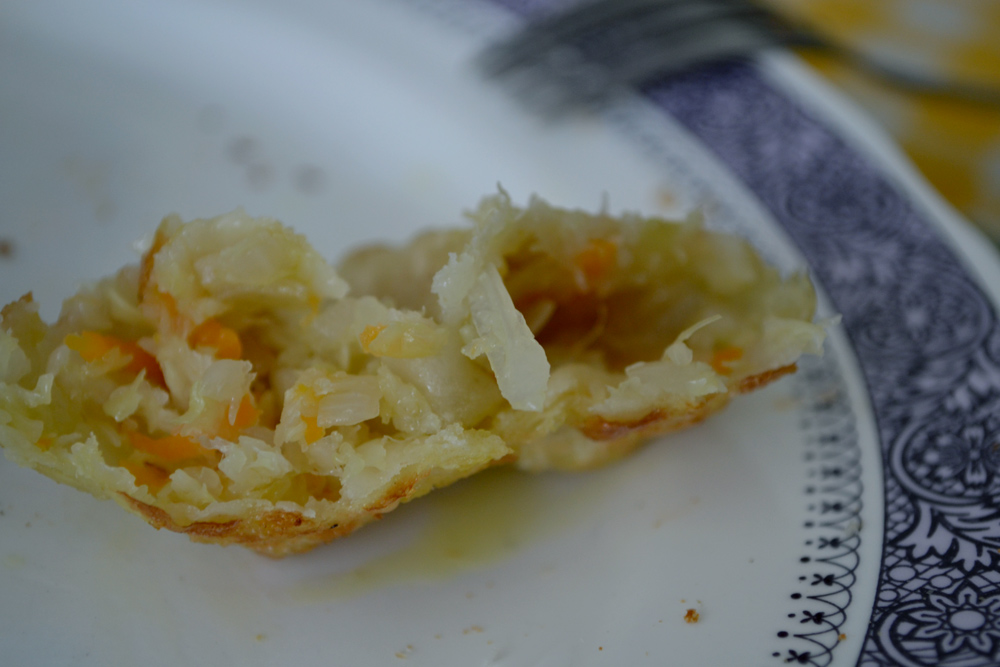
And for dessert, we often had some
kaju barfi. Yes, I like to say
barfi.
Kaju barfi is made from soaked cashew and sugar. The cashew element mellowed out the sweetness and actually reminded me a lot of Japanese
yokan (a sweet bean jelly dessert).
Barfi with a cup of straight second flush Darjeeling tea was heaven on earth.
Barfi even looks kind of like
yokan. Look at the bling on this!

Honestly, this was an intense trip. I am still trying to process all of the information and experiences I had there. It wouldn't be an exaggeration to say (even after the realities of car sickness and sweaty hikes up unstable rocks) that Darjeeling is magical. There is an energy there that pulls you in, taps you with its magic wand and sends you off again.
 Osewaninarimashita
Osewaninarimashita!
 Darjeeling reminded me of Hayao Miyazaki's Laputa: Castle in the Sky. It is hidden within the thick cloak of fog and has an elevation of up to 8000 feet. As you approach Darjeeling from the small, but heavily populated Bagdogra aiport, the steep hills slowly reveal themselves.
Darjeeling reminded me of Hayao Miyazaki's Laputa: Castle in the Sky. It is hidden within the thick cloak of fog and has an elevation of up to 8000 feet. As you approach Darjeeling from the small, but heavily populated Bagdogra aiport, the steep hills slowly reveal themselves.
 Looking down to the Junpana Tea Estate from the Goomtee Tea Estate, we are above the clouds.
The roads are unpaved, extremely narrow and get a lot of traffic, prompting a near-constant parade of 4x4s honking and passing each other with just a few inches between them. It was obvious that the only people who could drive on this terrain were born and raised here, with the ability to anticipate each curve and strategically placed rock that was the "guard rail" between you and a 2000ft cliff.
Looking down to the Junpana Tea Estate from the Goomtee Tea Estate, we are above the clouds.
The roads are unpaved, extremely narrow and get a lot of traffic, prompting a near-constant parade of 4x4s honking and passing each other with just a few inches between them. It was obvious that the only people who could drive on this terrain were born and raised here, with the ability to anticipate each curve and strategically placed rock that was the "guard rail" between you and a 2000ft cliff.
 Darjeeling is situated in West Bengal in the northeastern corner of India. It shares borders with Tibet, Nepal and Bhutan, therefore the two industries are border control (military) and tea. What a combo! Military facilities were especially abundant right outside the airport. Because of its proximity to China, the faces of people living there were very diverse. I felt like I fit right in with my East Asian face.
Darjeeling is situated in West Bengal in the northeastern corner of India. It shares borders with Tibet, Nepal and Bhutan, therefore the two industries are border control (military) and tea. What a combo! Military facilities were especially abundant right outside the airport. Because of its proximity to China, the faces of people living there were very diverse. I felt like I fit right in with my East Asian face.
 On our way to school
Most of the locals speak Nepali, but it is not uncommon to hear Bengali and Hindi as well. My untrained ear was unable to differentiate between these different languages.
I was on business for this trip and had the privilege of visiting a total of five tea estates, mostly situated in the Kurseong sub-district of Darjeeling (there are three wards in Darjeeling: Kalimpong, Kurseong and Siliguri).
I stayed in the bungalow at the Goomtee Tea Estate for four nights.
On our way to school
Most of the locals speak Nepali, but it is not uncommon to hear Bengali and Hindi as well. My untrained ear was unable to differentiate between these different languages.
I was on business for this trip and had the privilege of visiting a total of five tea estates, mostly situated in the Kurseong sub-district of Darjeeling (there are three wards in Darjeeling: Kalimpong, Kurseong and Siliguri).
I stayed in the bungalow at the Goomtee Tea Estate for four nights.
 It was established by the British in 1899 so the buildings are really classic, reminding me of my Grandma's English Tudor house she used to live in.
It was established by the British in 1899 so the buildings are really classic, reminding me of my Grandma's English Tudor house she used to live in.
 Creaky floors, lots of spiders, but great A-frame rooftops and deep brown wood flooring worn out by over a hundred years of people walking over them. The rooms were very comfortable, but I definitely had to get used to the fact that I had to turn the water heater on at least an hour before taking a shower.
Creaky floors, lots of spiders, but great A-frame rooftops and deep brown wood flooring worn out by over a hundred years of people walking over them. The rooms were very comfortable, but I definitely had to get used to the fact that I had to turn the water heater on at least an hour before taking a shower.
 Prem was the head chef at the bungalow.
Prem was the head chef at the bungalow.
 He showed me around their kitchen. There were usually a staff of three making our meals.
He showed me around their kitchen. There were usually a staff of three making our meals.


 All of the food was vegetarian and they harvest all of their herbs from the garden. The vegetables were all local as well, highlighting the fertility and abundance the Darjeeling's moisture and soil.
All of the food was vegetarian and they harvest all of their herbs from the garden. The vegetables were all local as well, highlighting the fertility and abundance the Darjeeling's moisture and soil.
 Goomtee garden, karipatta tree bottom left of the palm tree.
Goomtee garden, karipatta tree bottom left of the palm tree.
 Salted vegetables
There was always a protein element, often made out of beans (pictured here in the glass bowl on the top left hand side). And yogurt was mandatory for all meals, which was served after the main spread. With this combination, I did not feel like I was "missing" meat or lacking in energy. The meals there were cleansing and bright. It was quite a contrast from the Rogan Josh (mutton curry) I had in Delhi the day before.
Salted vegetables
There was always a protein element, often made out of beans (pictured here in the glass bowl on the top left hand side). And yogurt was mandatory for all meals, which was served after the main spread. With this combination, I did not feel like I was "missing" meat or lacking in energy. The meals there were cleansing and bright. It was quite a contrast from the Rogan Josh (mutton curry) I had in Delhi the day before.
 The bread was made fresh every day in their kitchen.
The bread was made fresh every day in their kitchen.
 Using whole grains, this was a very thin type of bread that reminded me of something closer to pita bread than naan. But even thinner than pita, it was just enough to scoop up everything on your plate without leaving you with a brick-load of bread in your stomach.
I also really enjoyed their use of different herbs. From the raw karipatta (curry leaf) which was often mixed into potato salads to native mustard seeds which were simmered into cabbage, the cuisine was bright and dimensional. It was a whole new world of flavors I was discovering everyday thanks to Prem and his staff's creations.
Using whole grains, this was a very thin type of bread that reminded me of something closer to pita bread than naan. But even thinner than pita, it was just enough to scoop up everything on your plate without leaving you with a brick-load of bread in your stomach.
I also really enjoyed their use of different herbs. From the raw karipatta (curry leaf) which was often mixed into potato salads to native mustard seeds which were simmered into cabbage, the cuisine was bright and dimensional. It was a whole new world of flavors I was discovering everyday thanks to Prem and his staff's creations.
 You can't come to Darjeeling and not notice the heavy Tibetan influence. Buddhist monasteries are everywhere, and vertical prayer flags line the perimeters of many towns.
You can't come to Darjeeling and not notice the heavy Tibetan influence. Buddhist monasteries are everywhere, and vertical prayer flags line the perimeters of many towns.
 Tibetan influence is also very apparent in the food. I was waiting for the appearance of momos during one of our meals. Prem does not disappoint! And on the third day, momos were served.
Tibetan influence is also very apparent in the food. I was waiting for the appearance of momos during one of our meals. Prem does not disappoint! And on the third day, momos were served.
 These were fried and, of course, vegetarian. The cooked vegetable texture was really pleasing and since it was lightly fried, there was enough flavor on it that these momos were not served with any sauce.
These were fried and, of course, vegetarian. The cooked vegetable texture was really pleasing and since it was lightly fried, there was enough flavor on it that these momos were not served with any sauce.
 And for dessert, we often had some kaju barfi. Yes, I like to say barfi. Kaju barfi is made from soaked cashew and sugar. The cashew element mellowed out the sweetness and actually reminded me a lot of Japanese yokan (a sweet bean jelly dessert). Barfi with a cup of straight second flush Darjeeling tea was heaven on earth.
Barfi even looks kind of like yokan. Look at the bling on this!
And for dessert, we often had some kaju barfi. Yes, I like to say barfi. Kaju barfi is made from soaked cashew and sugar. The cashew element mellowed out the sweetness and actually reminded me a lot of Japanese yokan (a sweet bean jelly dessert). Barfi with a cup of straight second flush Darjeeling tea was heaven on earth.
Barfi even looks kind of like yokan. Look at the bling on this!
 Honestly, this was an intense trip. I am still trying to process all of the information and experiences I had there. It wouldn't be an exaggeration to say (even after the realities of car sickness and sweaty hikes up unstable rocks) that Darjeeling is magical. There is an energy there that pulls you in, taps you with its magic wand and sends you off again.
Honestly, this was an intense trip. I am still trying to process all of the information and experiences I had there. It wouldn't be an exaggeration to say (even after the realities of car sickness and sweaty hikes up unstable rocks) that Darjeeling is magical. There is an energy there that pulls you in, taps you with its magic wand and sends you off again.
 Osewaninarimashita!
Osewaninarimashita!




Comments (6)
The pictures are beautiful! Darjeeling seems like a magical place. I’ve read so much about it but have never visited. I never knew there was a Tibetan presence there. The the food looks amazing. The momos look a bit like gyoza!
What a dream! I am so looking forward to more posts. It must have been life-changing with so many new experiences.
Did you feel the effects of colonization? Or just in the architecture?
I’ve never seen Laputa! I will do that immediately.
Yes, I did feel the effects of colonization. The locals of Nepali descent were the workers, while people in managerial positions came from big cities in India. So there is a difference in how these two groups look which was pretty obvious.
I felt this way in Tulum too. It was weird — most of the shop, restaurants and hotel owners were primarily expatriates and foreigners, while the people actually working behind the scenes (cooks, busboys, house cleaners) were the natives.
As a tourist, I felt like a contributing factor to that cyclical system of economy. It was all very controlled, and just didn’t feel quite right.
Dear Sirs, How to get over there to stay for a few days at least. Whom to be contacted and how to reach there. I am so fascinated by seeing all uploaded. I had been to some where near Nathu La border posted as a young Govt. Engineer to work for a Hydro-Electric Project. Stayed there for about five years. But could not get an opportunity to visit a Tea Estate except from a distance.
Dear Ratan,
Although I had a colleague show me around, you can also reserve stays at different tea estates independently. For example, you can reserve a stay at the Goomtee Estate by going to their website:
http://www.goomtee.com/visit.php